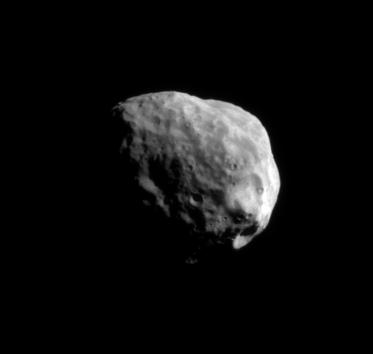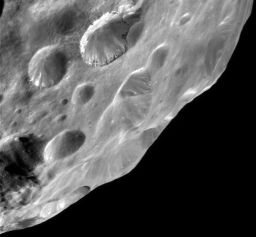Emily Lakdawalla • Apr 03, 2008
Playing around with Cassini images of Janus
Today's release from the Cassini imaging team was this one of Janus, a still from the sequence that I animated back in February. Just to orient you, Janus is one of Saturn's smaller moons; it orbits just outside the most visible part of the ring system, between the F and G rings. Janus shares its orbit with a smaller moon, Epimetheus, with which it changes places from time to time. At present, Janus is closer to Saturn and Epimetheus is farther; the two will switch places early in 2010.

NASA / JPL / SSI / animation by Emily Lakdawalla
Rotating Janus
The seven images in this animation of Saturn's moon Janus were captured by the Cassini orbiter as it passed within 200,000 kilometers of the moon on February 21, 2008. The view is down onto Janus' north pole, and during the time that separates the seven images, Janus rotates by several degrees, sending some craters into darkness and bringing others into daylight.These are the seven best images that Cassini has taken, which show the moon at a variety of different phase angles. I've resized the images so they all show Janus at the same scale of 1 kilometer per pixel, which is why some of them are fuzzy; all but one of them was enlarged to get to that scale. I did this enlargement based upon the metadata archived with the images, so it should be pretty accurate. Therefore, if some of these images make Janus look smaller than others, that's because Janus isn't a sphere; it's significantly flattened, being roughly 194 kilometers measured across its middle but only 150 kilometers measured through its rotational axis.

NASA / JPL / SSI / montage by Emily Lakdawalla


 Explore Worlds
Explore Worlds Find Life
Find Life Defend Earth
Defend Earth



